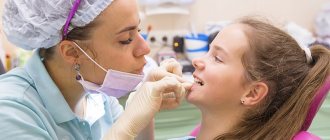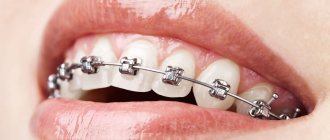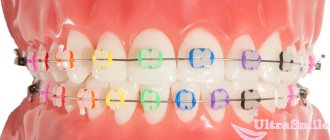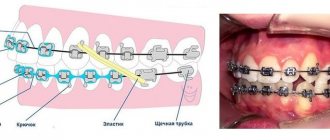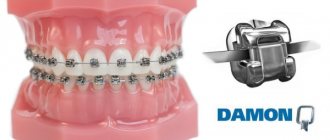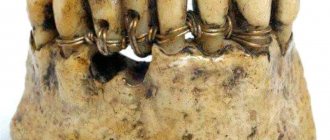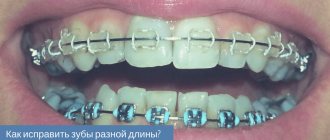Braces are non-removable orthodontic structures that remain in the oral cavity throughout the treatment process.
The duration of correction ranges from several months to two years. Braces cause some discomfort at the beginning of treatment, but later their presence becomes almost unnoticeable. However, every patient thinks about the day when it is time to remove them.
Thanks to modern technologies, it is possible to correct malocclusion or other dental anomalies at almost any age.
When are braces removed?
The duration of wearing braces directly depends on the type and severity of the pathology, as well as the age of the patient. The orthodontist selects the optimal option for the installed system and monitors the alignment process. As a rule, the first changes become noticeable after several months.
A qualified doctor is able to select the most appropriate treatment, which will speed up the achievement of the final result. The day when braces will be removed is determined based on the effectiveness of the braces system. When the effect of wearing it is stable, the orthodontist will set a date for removal.
How does the withdrawal process work?
The removal procedure is not complicated and usually takes from thirty minutes to one hour. Before removal, the doctor will advise you on all the details and give recommendations for dental care after completion of treatment. Any orthodontist can remove the system, even if he has not seen the patient. However, it is recommended to contact the specialist who was observed, since he knows the physiological characteristics and other subtleties of the correction process.
The manipulation itself consists of several stages:
- Preparation. Installation of a retractor to protect the oral mucosa;
- Removing ligatures. If they exist, there are non-ligature structures;
- Removing arcs. They are the ones who put pressure on the teeth during the treatment process;
- Opening braces. The so-called “locks” are opened using special dental pliers.
- Cleaning the surface of teeth from glue residues. It is done using a finisher - a special attachment on a drill.
It is also worth noting that sometimes removing the braces does not mean the end of the correction process. Often the procedure is resorted to due to breakdown or ineffectiveness of the chosen course of treatment.
How braces are removed at DDClinic
Removal of a classic ligature apparatus begins with the removal of rings and locks, continues by removing the arches and detaching the braces from the teeth, and ends with cleansing the tooth enamel from the remnants of the fixing material. The whole procedure takes a few minutes.
In the case of a non-ligature system, the lock on each bracket is first opened, and then the same manipulations are performed as when removing the ligature system.
Lingual braces are attached to the inside of the teeth, so they take a little longer to remove - approximately 30 minutes.
Does it hurt to remove braces?
The procedure does not cause pain. The process may cause some discomfort. Depending on the qualifications of the orthodontist, it may be minimal. Therefore, it is recommended to contact professionals. The more experienced the doctor, the faster and better the treatment will be completed.
Pain may be caused due to individual physiological characteristics. For example, increased tooth sensitivity or low pain threshold. If the system is removed by an orthodontist who accompanied the patient throughout the correction, he will take measures to minimize the negative effect or its complete absence.
Do teeth with braces hurt a lot and what can you do about it?
Fixing braces is a painless procedure. But after the orthodontic archwire is installed in the braces, pressure will be placed on the teeth. Therefore, for several days after installation and each new arch replacement, the teeth may ache a little.
How much your teeth will hurt depends on the characteristics of your body and its pain threshold. According to statistics, 10% of patients’ teeth do not hurt at all, more than half report minor pain, and only 5% of brace wearers report severe pain.
In any case, the discomfort goes away after a few days, and the orthodontist will advise which painkiller is best to take if the pain greatly ruins your life.
So putting on braces is not painful, but rather a little unpleasant. But for the sake of the beauty of your smile and your own health, you can endure a little.
Why you can’t remove braces yourself at home
Without special knowledge and tools, it is strictly not recommended to remove braces. Today there is enough provocative information on the Internet about removing braces yourself, but you should not follow the lead of unqualified people. Independent intervention can lead to damage to the mucous membrane, teeth, and gums.
Even if you have some knowledge in dentistry, you should not remove braces yourself, because after that you will need to install retainers. It will not be possible to purchase and install correctly without special equipment. Also, without a drill it is impossible to remove residual glue from tooth enamel. Intervention will lead to damage or complete elimination of the therapeutic effect.
If one “lock” comes unglued, you should not remove it yourself. This will cause damage to the structure. It is recommended to visit your doctor as soon as possible, since the failure of one element will lead to a decrease in pressure on the teeth, which will reduce the effectiveness of treatment. If it is not possible to make an appointment, you can temporarily secure the braces with medical wax, which can be found at the pharmacy.
What procedures are carried out after removing braces?
After removing the system, glue residues remain on the surface of the teeth and minor damage to the enamel is observed. Therefore, several procedures are performed to restore aesthetic appearance and structural integrity:
- Hygienic cleaning;
- Remineralization.
Cleaning is done using a drill attachment. This allows you to remove not only glue residues, but also tartar and plaque that accumulate under braces during the treatment period. The procedure does not cause pain and takes about 10 minutes.
Remineralization involves applying a special composition to the surface of the teeth. This allows you to saturate the tissues with fluoride and minerals, which accelerates tissue restoration after prolonged stress while wearing braces.
Important! It is not recommended to carry out the teeth whitening procedure for at least a month after completion of the correction. This time is necessary for the restoration of the enamel. After removing the system, sensitivity will increase, which will lead to toothache.
Indications for replacement
The gradual restoration of shape leads to a weakening of the pressure exerted on the maxillary arch. In the case of a planned replacement, the procedure is designed to maintain directional traction, under the influence of which the problematic units continue to move into their natural anatomical position. In some brace designs, the wire tension is changed using a screw element, but each arch has a limit, which is not always enough to complete the correction cycle.
In situations where replacement is caused by the occurrence of mechanical defects that preclude the possibility of further operation of the structure, it is impossible to postpone a visit to the doctor until the next scheduled date - otherwise the entire correction cycle will have to start over again. Such cases are extremely rare - today high-strength materials are used to make braces, the likelihood of breakage of which is minimized.
Retainers are not the end, but they are already the result
After removing the braces system, the pressure on the teeth is removed. The teeth will try to return to their original state, which will completely negate all efforts. To prevent this, retainers are installed - devices that fix the teeth in the desired position. Divided into two types:
- Fixed;
- Removable.
The first includes a thin wire, which is attached from the inside to the dentition using the material from which fillings are made. Outwardly invisible, does not affect diction, does not cause discomfort. Some patients have to wear this design for the rest of their lives.
Removable structures include special silicone trays or plates that are placed on problem areas. To make a mouthguard, an impression is made of the patient’s dentition, which allows you to accurately hold the teeth in the required position. Typically, removable retainers are used for dressing while sleeping.
What to do after treatment?
In fact, treatment does not end with the removal of orthodontic structures. There is still a period of retention ahead - the process of maintaining the results of correcting the defect with the help of a retainer. After all, after removing the device, straight teeth tend to return to their original position. Without retention, the risk of the dentition returning to its original position is too great, since the dental roots, having gained mobility during the alignment process, remain so for some time. So, the question “does it hurt to get braces off?” not the sharpest. Much more important is the issue of choosing the right retainer, as well as compliance with all dental appointments and the timing of its wearing.
Attention! It is prohibited to remove braces yourself! In this case, it is really painful and even dangerous. If you installed the system at the DD Clinic, then it is advisable to remove them from the same doctor.
Oral care after removing braces
Wearing braces for a long time wears down the enamel of your teeth. Therefore, it will take time and some effort to completely restore the tissue. It is recommended to use toothpaste with a high fluoride content, use dental floss and mouthwash after meals, and massage the gums.
Do not forget about the reminalizing gel, which will be prescribed by your doctor. It must be applied in accordance with the recommendations, without skipping procedures. You will also need to visit an orthodontist to monitor dental movements and adjust treatment.
What can you eat with braces?
There are no big prohibitions on certain foods during orthodontic treatment, but it is better to adhere to the following rules:
- In the first days after installation and activation, while your teeth ache, it is better to eat soft and liquid food - porridge, puree soups, smoothies, yoghurts and curds. This will make it easier to get used to your new state.
- There is no need to eat sticky foods that can get stuck in the braces and damage them. And even if they don’t damage them, it’s difficult to clean them out later. Therefore, toffees, caramels, chewing gum, as well as cookies, baked goods, and other foods that become sticky when chewed are prohibited.
- Do not eat hard foods - crackers, nuts, pieces of meat, etc. — they can easily damage your braces. For the same reason, cut raw vegetables and fruits into small pieces.
- Don't forget that products such as tea, coffee, colored drinks, beets, blueberries, etc. may change the color of some types of braces and ligatures on them. And sitting in a cafe with a brace system full of, for example, red beets is not very aesthetically pleasing. So think about it.
- If your brace system has thermo-active orthodontic wires, then you cannot eat ice cream or drink ice water. The fact is that at ordinary temperatures a thermoactive arc can be given any shape. Then, under the influence of a person’s body temperature, it “remembers” the shape that was put into it during production and begins to work. And here you are with your ice cream...
Where to go?
The modern world has taken demands on human appearance to a new level. A beautiful smile is the key to success in communicating with new people. Therefore, to correct maxillofacial anomalies, it is worth contacting specialists with extensive experience in solving such problems. The Karmen-Med clinic has a staff of doctors with more than tens of years of experience.
Our clinic provides a full range of services. The latest equipment meeting international standards has been installed. The cost of providing the service depends on the specific features of each case, on average ranging from 7,000 to 12,000 rubles. We guarantee painless treatment and an individual approach to each patient. Trust your smile to professionals!

